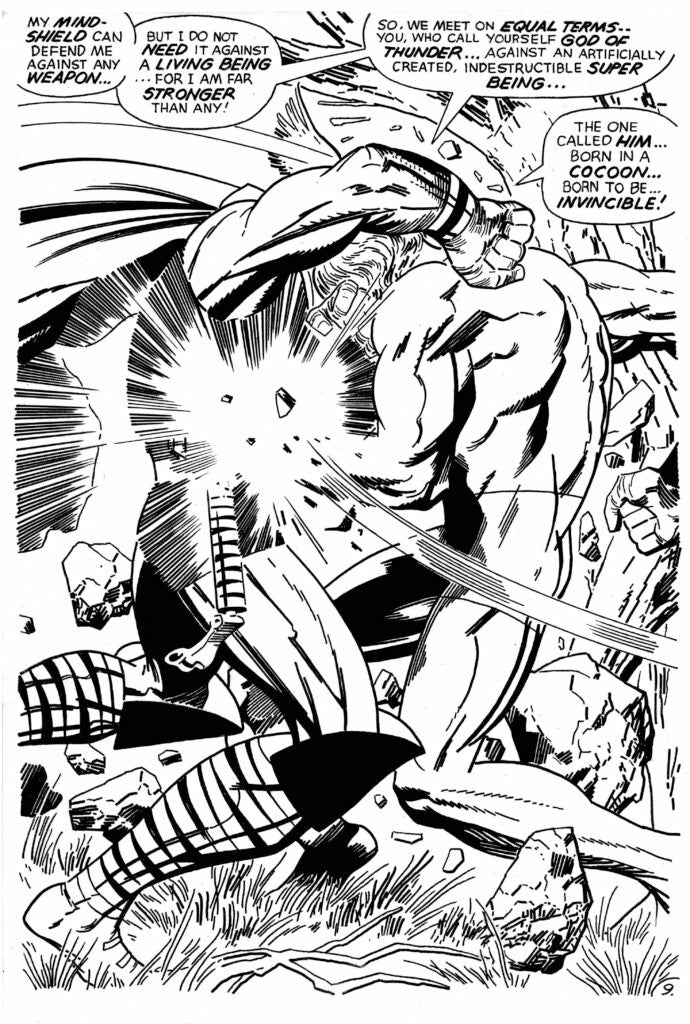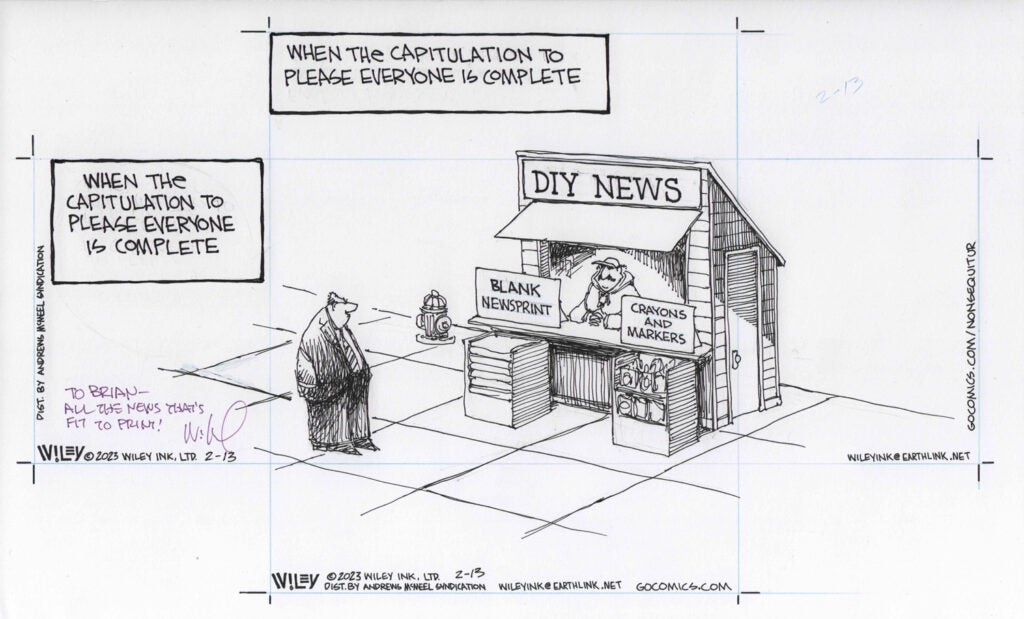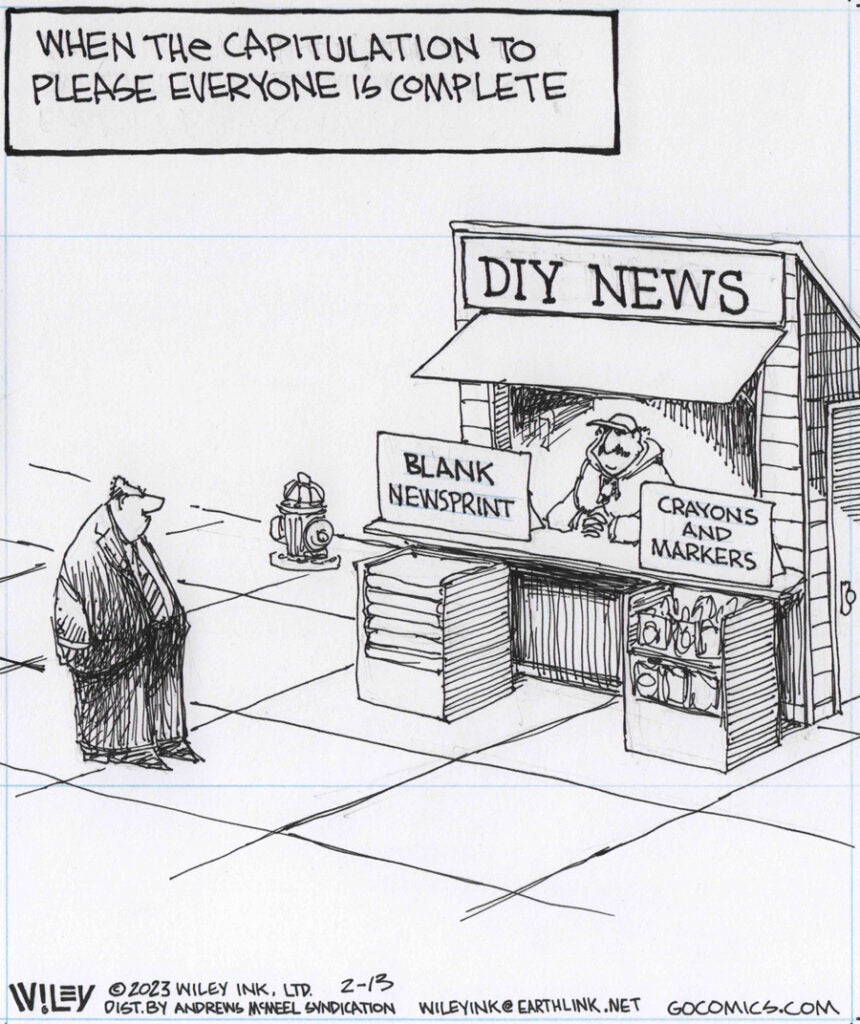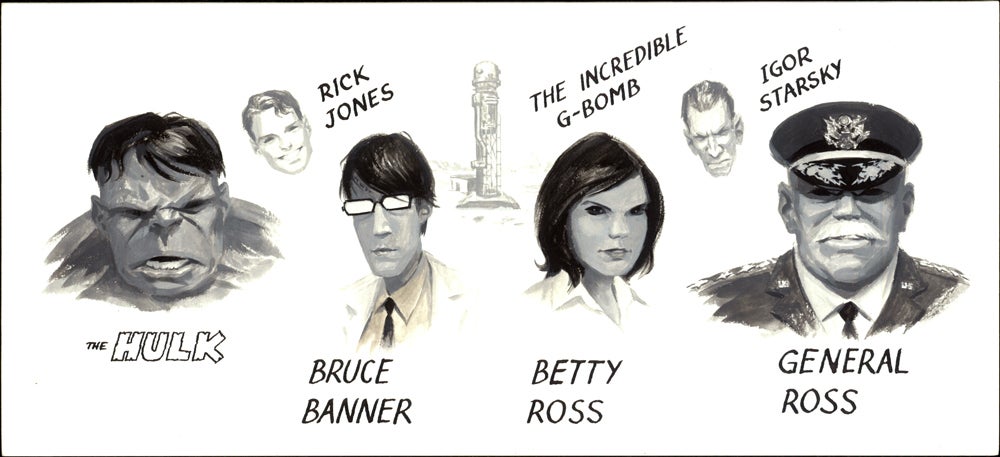Thor 166 p 9 (2021)
by Mike DeCarlo (1957 -)
11 x 17 ink on paper
commission

From the July 1969 issue of Thor. Inked by Mike over a copy of the Kirby pencils.
 Brian P Coppola
Brian P Coppola
Thor 166 p 9 (2021)
by Mike DeCarlo (1957 -)
11 x 17 ink on paper
commission

From the July 1969 issue of Thor. Inked by Mike over a copy of the Kirby pencils.
“Research is a Nuisance” (Non Sequitur, March 12, 2023)
by Wiley Miller (1951-)
16.66 x 6.33 in., ink on heavy paper
Coppola Collection

https://en.wikipedia.org/wiki/Wiley_Miller
In 1991, Wiley launched his popular Non Sequitur strip, eventually syndicated to 700 newspapers as well as published on Go Comics and distributed via email. The strip oscillates between one-panel commentary and stories with recurring characters. In either event, the strips have a history of politically leaning and sharp commentary. I really wanted Danae’s commentary in the last panel, not only because it was so representative of the anti-intellectualistic, post-truth world (“Research is a stupid nuisance that takes the fun out of stuff you think is probably right.”)
I asked Wiley to inscribe the strip with one of my all-time favorite quotes about science. From 1834, the letters from Liebig to Berzelius, that I stumbled upon by accident and understood just enough German to recognize as interesting:
Die schönsten Theorien werden durch die verdammten Versuche über den Haufen geworfen, es ist gar keine Freude mehr Chemiker zu sein.
… which, roughly, translates as “The most beautiful theories are thrown onto the heap by these damned experiments, it is no fun at all to be a chemist any more.”
“DIY News” (Non Sequitur, February 13, 2023)
by Wiley Miller (1951-)
8.5 x 14 in., ink on heavy paper
Coppola Collection



https://en.wikipedia.org/wiki/Wiley_Miller
In 1991, Wiley launched his popular Non Sequitur strip, eventually syndicated to 700 newspapers as well as published on Go Comics and distributed via email. The strip oscillates between one-panel commentary and stories with recurring characters. In either event, the strips have a history of politically leaning and sharp commentary. I was strongly taken by the comment here and I am pleased to have this art to display. Completely democratizing the world through self-publication on the Internet flattened the world (sic, Thomas Friedman), much like the step of the elephant flattens the mouse.
The note from Wiley: “All the News that’s Fit to Print”
A reminder – Wiley composes these to be able to be cropped as a horizontal or vertical format (see additional images).
Hulk Mythos (Character study) by Paolo Rivera (2006)
by Paolo Rivera (1981-)
5 x 11 in., guache on heavy paper
Coppola Collection

As in all of the Mythos stories, this is a fully painted retelling of the origin and earliest days of classic Marvel characters. Here is the character study for Hulk Mythos.

“Blue Meanies No. 5 of 9” (2021)
by Carson Grubaugh (1981- )
11.75 x 16 in. on 2 pages, blue ballpoint ink on paper
Coppola Collection
When “The Strange Death of Alex Raymond” was initially printed during the summer of 2021, the printer made a critical and quite mysterious error, leaving off four pages worth of blue-line printing that caused the entire edition to be scrapped and the release of the book to be delayed for several months while the printer gathered the materials for a full reprint. Even odder, Carson and Dave had a history of printing issues related to blue line artwork when working on the second half of the book, what Dave referred to in conversation with Carson as “the Blue Meanies.” After the book was finally correctly printed in November, Carson took nine of these misprinted copies and created original artwork on two of the pages missing printing, depicting the “Blue Meanies” in each copy, each one unique, and in blue ballpoint ink, of course. The draw appears on pp. 256-257.
I put my request in for one of these, immediately, and Carson did me a solid: not only reserved one for me, but turned me into the Blue Meanie in my copy.


“Iron Man Cave” (2022)
by Carson Grubaugh (1981- )
6.8 x 10.5 in., ink on paper
Coppola Collection

At the Patreon site organized by Sean Michael Robinson and Carson Grubaugh, which accompanies their collaboration on “Living the Line,” they offer a premium based on Carson’s Google Grab-Bag schtick.
He offers an original straight-to-ink sketch. Here is how that works. You are asked to provide a word or phrase (and obviously you can game this a bit). Carson then searches this word or phrase using Google Images. The first photographic image listed by Google Images will be the source material for the straight-to-ink sketch.
Carson has got a great eye. In fact, it freaks me out. He can use a brush (or pen) on paper with NO underlying outline, lay down lines or brushstrokes all over the page, and in about 20-30 minutes he produces a sketch. And all without the training wheels! He records it live. There are videos of this on YouTube (and at the Patreon site).
The April 2022 Grab-Bag phrase came from me. The first vote was between “Cave Iron Man,” “Chris Evans Cap throws shield,” “Dave Sim & Matt Dow” and “Dave Sim & Margaret Liss.” And then a tiebreaker between between “Cave Iron Man” and “Dave Sim & Margaret Liss.”

“Spider-man swinging pose Andrew Garfield” (2022)
by Carson Grubaugh (1981- )
8.5 x 11 in., ink on paper
Coppola Collection

At the Patreon site organized by Sean Michael Robinson and Carson Grubaugh, which accompanies their collaboration on “Living the Line,” they offer a premium based on Carson’s Google Grab-Bag schtick.
He offers an original straight-to-ink sketch. Here is how that works. You are asked to provide a word or phrase (and obviously you can game this a bit). Carson then searches this word or phrase using Google Images. The first photographic image listed by Google Images will be the source material for the straight-to-ink sketch.
Carson has got a great eye. In fact, it freaks me out. He can use a brush (or pen) on paper with NO underlying outline, lay down lines or brushstrokes all over the page, and in about 20-30 minutes he produces a sketch. And all without the training wheels! He records it live. There are videos of this on YouTube (and at the Patreon site).
The March 2022 Grab-Bag phrase came from me. A new high-tier member joined, so there was a 5-way contest. I went with the superhero route, drawing on Spider-Man: No Way Home. I suggested “spider-man swinging pose Andrew Garfield,” “spider-man swinging pose Tobey Maguire,” and “spider-man swinging pose Tom Holland.” In addition there was “Matt Dow & Dave Sim” and “Margaret Liss & Dave Sim.”
Andrew Garfield was the winner.

“John Vassos Phobia” (2022)
by Carson Grubaugh (1981- )
8.5 x 11 in., ink on paper
Coppola Collection

At the Patreon site organized by Sean Michael Robinson and Carson Grubaugh, which accompanies their collaboration on “Living the Line,” they offer a premium based on Carson’s Google Grab-Bag schtick.
He offers an original straight-to-ink sketch. Here is how that works. You are asked to provide a word or phrase (and obviously you can game this a bit). Carson then searches this word or phrase using Google Images. The first photographic image listed by Google Images will be the source material for the straight-to-ink sketch.
Carson has got a great eye. In fact, it freaks me out. He can use a brush (or pen) on paper with NO underlying outline, lay down lines or brushstrokes all over the page, and in about 20-30 minutes he produces a sketch. And all without the training wheels! He records it live. There are videos of this on YouTube (and at the Patreon site).
The February 2022 Grab-Bag phrase came from me. In fact, all three phrases that were voted on came from me. I really like the art of John Vassos, so I offered up “John Vassos Phobia,” “John Vassos Wilde’s Salome,” and “John Vassos Ultimo.”
Phobia was the winner.

“Ansel Adams Vietnam” (2022)
by Carson Grubaugh (1981- )
8.5 x 11 in., ink on paper
Coppola Collection
The source image:

At the Patreon site organized by Sean Michael Robinson and Carson Grubaugh, which accompanies their collaboration on “Living the Line,” they offer a premium based on Carson’s Google Grab-Bag schtick.
He offers an original straight-to-ink sketch. Here is how that works. You are asked to provide a word or phrase (and obviously you can game this a bit). Carson then searches this word or phrase using Google Images. The first photographic image listed by Google Images will be the source material for the straight-to-ink sketch.
Carson has got a great eye. In fact, it freaks me out. He can use a brush (or pen) on paper with NO underlying outline, lay down lines or brushstrokes all over the page, and in about 20-30 minutes he produces a sketch. And all without the training wheels! He records it live. There are videos of this on YouTube (and at the Patreon site).
The January 2022 Grab-Bag phrase came from me. In fact, all three phrases that were voted on came from me. In honor of Ansel Adams, I offered up “Ansel Adams Vietnam,” “Ansel Adams Japan,” and “Ansel Adams Tibet.”
Vietnam won (so to speak). The picture that Carson worked from is in the additional images.
 “Cerebus: Elrod Advises, Cerebus Kvetches” (est. 1979)
“Cerebus: Elrod Advises, Cerebus Kvetches” (est. 1979)
by Dave Sim (1956-)
11 x 14 in., ink and marker on board
Coppola Collection
Jan 2021: I was looking for something in a closet that I had not been in for a while and came across this little treasure. I recognized it (really, who wouldn’t?) but it was still bagged and taped onto the cardboard backing from whenever it was shipped to me. I had neglected to scan, log and posting it into my inventory.
Tarim! A treat to start 2021.
The text of Elrod’s dialogue: “Stand up, son – you’re tripping all over yourself. You’ve got to learn to stand on your feet – I may not always be around to help you.”
About which Cerebus notes: “Now you know how Cerebus feels.”
This drawing looks to be unfinished. Obviously, the Elrod dialogue is drafted in pencil. I might have almost thought the Cerebus figure was added later, except for the inclusion of his dialogue within the Elrod figure itself. At 11 x 14, it is larger than the usual convention drawings, too.
The drawing is undated. Elrod was popular when Dave introduced him (Cerebus #4, June 1978), and he returned in Cerebus #7 (December 1978), and I think the character was a popular request for convention drawings in 1979. I have a few drawings of Elrod and Cerebus with 1979 dates that match up well with these Elrod and Cerebus styles and this color scheme. Not to mention (<cough>ahem<cough>), this is a great companion piece for the original art to the cover of issue #4, and you know where that is.
